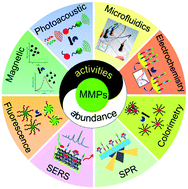Biosensors and bioassays for determination of matrix metalloproteinases: state of the art and recent advances
Abstract
Matrix metalloproteinases (MMPs) are closely associated with various physiological and pathological processes, and have been regarded as potential biomarkers for severe diseases including cancer. Accurate determination of MMPs would advance our understanding of their roles in disease progression, and is of great significance for disease diagnosis, treatment and prognosis. In this review, we present a comprehensive overview of the developed bioassays/biosensors for detection of MMPs, and highlight the recent advancement in nanomaterial-based immunoassays for MMP abundance measurements and nanomaterial-based biosensors for MMP activity determination. Enzyme-linked immunosorbent assay (ELISA)-based immunoassays provide information about total levels of MMPs with high specificity and sensitivity, while target-based biosensors measure the amounts of active MMPs, and allow imaging of MMP activities in vivo. For multiplex and high-throughput analysis of MMPs, microfluidics and microarray-based assays are described. Additionally, we put forward the existing challenges and future prospects from our perspective.

- This article is part of the themed collections: Editor’s Choice: Microfluidics and Biosensors


 Please wait while we load your content...
Please wait while we load your content...